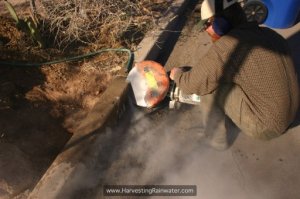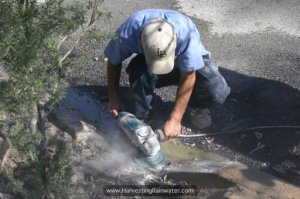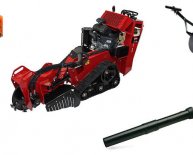
Curb Making machine Rental
 By Brad Lancaster, www.HarvestingRainwater.com
By Brad Lancaster, www.HarvestingRainwater.com
This is a supplement to “How To Cut Curbs and Harvest Street Runoff” in chapter 8 of Rainwater Harvesting for Drylands and Beyond, Volume 2, 2nd Edition. That is why this supplement begins at Step 7. Please read both chapter 8 (for the very important steps and information that precede and follow the cutting of the curb, such as observing water flow, marking all utility lines, maintaining pedestrian access, obtaining a permit, how to make the basin and place its curb cut, and important elevation relationships) and this supplement.
MAKE YOUR CUTS
I recommend that novices make only one curb cut to start. See how it works in the next big rain, and if all is well you can make the rest of the cuts. If things go wrong, fix them, and reconsider making more cuts.
7. Rent a concrete saw
Search “Curb-Cut & Curb-Core Costs” on this website for cost estimates & tool specifications.
8. Cut the curb
Concrete-cutting services make the cleanest cuts. While some communities allow citizens to make their own permitted curb cuts, mine currently requires that a licensed contractor do the work. Check with your local authorities (often the landscape architect with your local transportation department) to see what is legal in your area.
If you do the cuts, use a large, hand-held, gas-powered concrete-cutting circular saw (with diamond-carbide blade) from a rental center. The blade should be at least 14 inches (35 cm) in diameter, which allows you to cut curbs up to 6 inches (13.7 cm) tall and wide. Larger curbs will likely require a larger, heavier (and harder-to-use) saw with a 20-inch (50-cm) blade. Make your cuts in steps.
- Dig away all dirt from the inside (non-street side) of the curb where the cuts will occur.
 This should already be done if you’ve pre-dug the basin that will receive the water coming from the cut you are about to make.
This should already be done if you’ve pre-dug the basin that will receive the water coming from the cut you are about to make. - Measure and mark all cut lines with a thick pencil before you begin. Make your lines (and subsequent cuts) straight and professional—we want to improve public property, not make it worse. A speed square is great for marking straight lines.
- On the street-side of the curb (be sure you’re wearing eye and ear protection), make your first cut at a 45º angle down to the level of the pavement (fig. 1). Do not go any deeper than the level of the pavement because you need the intact curb beneath the street to act as a stabilized spillway. Hold the body of the saw perpendicular to the curb to make a cut that goes straight through the curb (so when viewed from above, the line of the cut will form a 90º angle with the side of the curb). Then get into the basin and complete the cut by cutting in the opposite direction. (Make sure your local officials approve a 45º angle before you do it. Some officials want more gradual cuts, which can be made only with a saw having a blade that is larger than 14 inches (35 cm) in diameter, or by a concrete-cutting service.) Now repeat the same procedure to cut the other end of the curb cut.
Note: To reduce dust, excessive wear on the saw blade, and the rental cost of the saw (you are charged for blade wear), run water lightly over the concrete as you are cutting, and don’t force the cut—just let it happen at its own pace.
- To make the horizontal cut, you’ll need to temporarily dig out enough soil from the inside of the curb to allow for the clearance of the saw held horizontally. Then make the cut (figs. 2 and 3). From the street side of the curb, make another horizontal cut (though it will be only a shallow cut and slightly angled because you can’t get the saw beneath the pavement for a truly horizontal, level cut).
- Once all cuts are made, knock out the cut piece of curb with a sledgehammer (fig. 4).
- Smooth out all your cuts with an industrial hand-held grinder (fig. 5).
Take the time and effort to make good-looking, clean cuts so that your work will help to promote, rather than ban this practice. You want to enhance public property, not detract from it. Don’t get lazy and use a sledgehammer without first making all the cuts or you may crack and weaken the curb. That curb keeps the street—your source of runoff—intact.
9. Make sure your curb cut acts as both your inflow location and overflow location for street-runoff water. Make the bottom of the infiltration basin deeper than the level of the street so water flows into it. Make sure the non-curb edge of the basin is the same elevation as, or higher than, the top of the street curb. This will force excess water to flow back into the street, not into the adjoining property where it could create flooding problems, of which you do not want to be the cause. This also avoids legal problems relating to surface-water rights by keeping the water harvested from the public street in the public right-of-way.
If the top edge of a basin is an earthen path, compact it to an elevation 2 inches (5 cm) above the level of the curb to compensate for additional compaction and settling that will occur with use. Concrete sidewalks don’t settle so they can be built at the level of the top of the curb.

















